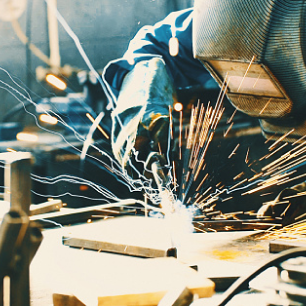Jump to:
The Answer Is
Q: I need some direction on preheat. I’ve been tasked with a repair job on a 12-in. diameter bar fabricated from high-strength, low-alloy steel. The chemistry of the steel is the same as that of an AISI 4340 alloy steel. If the steel was a regular everyday steel used for a building or bridge, I could look it up in AWS D1.1, Structural Welding Code — Steel. This thing I have to weld is a creature of a different color. It contains chrome, nickel, molybdenum, and a good amount of carbon. How do I find the preheat requirements to ensure the repair doesn’t crack.
A: I have responded to several questions on preheat here in this column, but I don’t recollect one being as specific as this one. I’ll offer you the approach I use.
The chemistry of the AISI 4340 alloy steel is roughly 0.4% carbon, 0.78% manganese, 1.8% nickel, 0.8% chromium, and 0.3% molybdenum. The equations and guidelines in AWS D1.1/D1.1M, Structural Welding Code — Steel, will not help you with this alloy.
The trick is to use sufficient preheat to reduce the cooling rate to prevent the austenite from decaying into martensite. With the combination of martensite, high residual stresses will push delayed cold cracking once the weld cools.
I use isothermal diagrams to tell me the temperature at which martensite starts to form. To complicate matters, time also comes into play, and isothermal diagrams give us that information.
Returning to your problem, how much preheat is needed to prevent the formation of martensite in the weld or the heat-affected zone when welding AISI 4340? I use the isothermal diagram found in Atlas of Time-Temperature Diagrams for Irons and Steels from the American Society of Materials (ASM). AISI 4340 steel will form martensite rather easily if austenite is cooled below 600°F in less than a minute. In contrast, if the temperature is maintained above 600°F, austenite will decompose into ferrite and carbide. After about one hour at 600ºF, all the austenite will have decomposed into ferrite and carbide. Thus, there is no retained austenite to decompose into martensite.
Considering the bar you are welding is 12 in. in diameter, it will take longer than an hour to weld. So, if you use a preheat and maintain the interpass temperature at 600°F or a little higher, you effectively prevent the decay of austenite into martensite. Without martensite, there is little danger of delayed cold cracking. Problem solved!
ASM is to the metallurgist what the AWS is to the welding engineer, inspector, and welder. AWS publishes welding standards to help us design welds, and ASM publishes references the metallurgist can use to predict how metals will respond to various heat treatments. The ASM references the Atlas of Time-Temperature Diagrams for Iron and Steels. It is my “Bible” when AWS structural welding codes do not list welding steels. The book includes pages of isothermal diagrams that provide hours of entertainment.
A short description of how to use an isothermal diagram is probably in order. Figure 1 depicts an isothermal diagram for a hypothetical alloy I’ll call Al-alloy (so I don’t get whacked with copyright infringement), which is very similar to the alloy known as unobtanium.
The isothermal diagram in Fig. 1 shows how austenite decomposes into various microstructures when the metal is cooled from the austenitizing temperature and held at a specified temperature for a long time. The left side of the diagram shows the temperature, and the bottom axis shows time in seconds. The lower temperature of transformation for carbon steel is about 1335°F, which correlates closely with the horizontal line labeled As toward the top of the diagram. That is the temperature at which the steel will start to transform into austenite (face-centered cubic). However, the steel isn’t completely transformed to austenite until it has reached a temperature of about 1450°F (remember, this is an imaginary alloy of steel: Al-alloy). Above 1450°F, the crystalline structure is face-centered cubic. It is austenitized. All the alloying constituents are in solution. Now, the alloy is cooled to a specified temperature and held at that temperature. This is usually accomplished by immersing a sample of the steel in a molten metal bath to maintain the temperature constant.
Using Fig. 1, draw a horizontal line at the temperature of 1000°F. Moving along the line from the left side of the graph (1000°F) toward the right, initially nothing happens. After about 80 seconds, the austenite will decay into austenite and ferrite, as indicated by the region to the right of the first curved line. Now, draw a vertical line at 900 seconds. The second vertical line intersects the second curved line, indicating the microstructure consists of retained austenite and ferrite. As you move further to the right, the retained austenite decays into ferrite and carbides (pearlite). If the horizontal line (1000°F) is followed further to the right, it will roughly intersect the third curved line, where a vertical line is drawn just shy of 106 seconds. The decay of austenite is complete, and just shy of 106 seconds has passed. The decomposition results in pearlite. One could now allow the Al-alloy to cool to room temperature without forming martensite because there is no retained austenite.
If we cool the sample quickly from the austenitizing temperature (≈ 1450°F) down to 550°F in ten seconds, the Al-alloy will decompose into martensite. This gives you a good idea of what would happen if you attempted to weld without preheat. The rapid cooling bypasses the left curve shown in Fig. 1 and drops into the region identified as Ms (martensite start), and austenite starts to decay into martensite. If the sample is cooled to 450°F, roughly 50% has decomposed into martensite. As the sample is cooled further, the retained austenite will decay to increase the percentage of martensite. When the sample is cooled sufficiently, about 90% of the sample will be martensite. Without cryo-quenching, the transformation to martensite is complete at 90%.
That’s a lot to digest — nearly a semester’s worth of metallurgy in just a few paragraphs.
Now for the fun stuff. I use the isothermal diagrams to identify the temperature at which the austenite begins to decay into martensite. That temperature is key because no martensite will form if I use a preheat temperature above the Ms temperature. It’s magic! All I have to do is maintain an interpass temperature above Ms and there is no chance of forming martensite. Thus, there is little probability there will be a problem with delayed cold cracking. If the preheat is insufficient, there is the potential to form martensite. To complicate matters, at temperatures below 450°F, the nascent hydrogen can’t easily escape (effuse) into the environment, and given sufficient time (I can hear it now), CRACK!
Are there other considerations? Certainly there are.
Like what? The use of a low hydrogen welding process, storing the low hydrogen shielded metal arc electrodes at a minimum of 250°F to ensure they are free of moisture, and ensuring the surfaces to be welded are clean, dry, and free of any hydrocarbons; in short, what we call low hydrogen welding practices.
Some people will say, “Al, you don’t need to preheat above the Ms temperature.” I won’t argue the point. I’m sure they can preheat to a lower temperature and obtain crack-free welds, but as the preheat temperature is reduced, the probability of delayed cold cracking increases due to the increased potential to form Martensite. So, my response is, “Do you feel lucky?”
Most of the repair work I do is on one-of-a-kind machines. The lead time to obtain a replacement part may be one to two years. In the meantime, the machine isn’t running, and the customer can lose upwards of one to two million dollars daily. My customer doesn’t have the time to qualify for a welding procedure specification to prove that a lower preheat temperature will work. We have one shot at making the repair; the goal is to get the machine back into operation as soon as possible.
My approach is fairly conservative. The cost of the extra preheat is a drop in the bucket in comparison to the cost of a failed weld and the resulting lost revenue. Many of my repairs on alloy steels follow various heat treatments that might include in-process stress relief, stress relief, normalizing, and even quenching and tempering. Other than die steels, annealing isn’t something I have to contend with.
I hope this gives you a rational means of determining the preheat for the low alloy and alloy steels you may encounter.
ALBERT J. MOORE JR. (amoore999@comcast.net) is owner of NAVSEA Solutions/Marion Testing & Inspection, Burlington, Conn. He is an AWS Senior Certified Welding Inspector and an ASNT NDT Level III. He is also retired from the AWS Qualification & Certification Committee on Methods of Inspection and the Inspection of Welds Committees.
The Society is not responsible for any statements made or opinions expressed herein. Data and information developed by the authors are for specific informational purposes only and are not intended for use without independent, substantiating investigation on the part of potential users.


